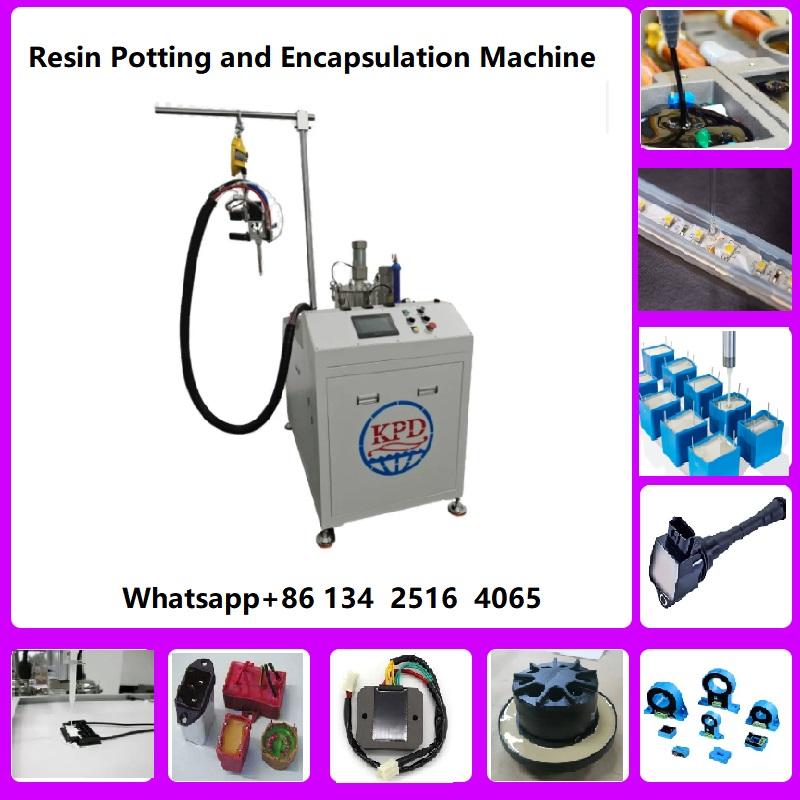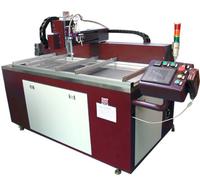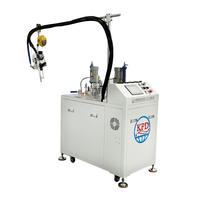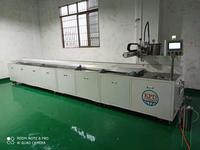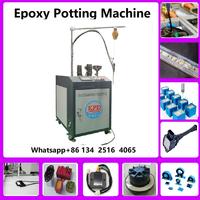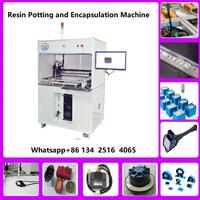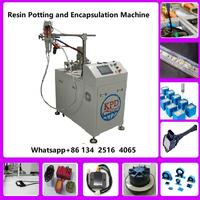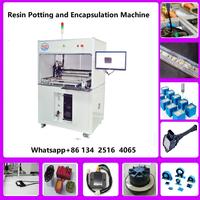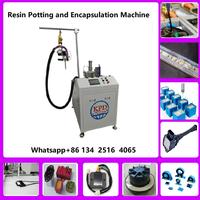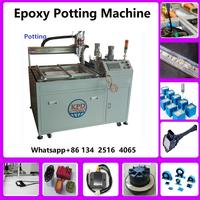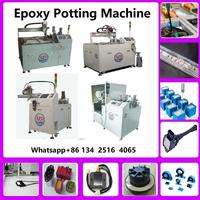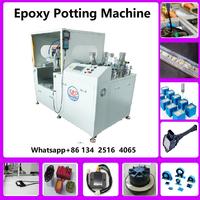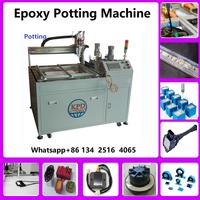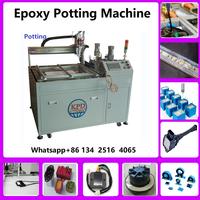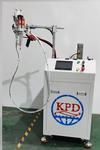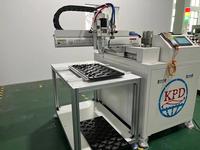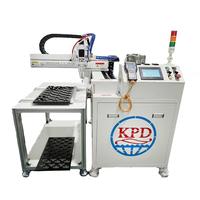AB component pouring 2K silicone epoxies polyurethanes system metering and dosing system
Company Information:
Name: |
AB component pouring 2K silicone epoxies polyurethanes system metering and dosing system |
Category: |
|
Offered by: |
|
AB component pouring 2K silicone epoxies polyurethanes system metering and dosing system Description:
AB component pouring 2K silicone epoxies polyurethanes system metering and dosing system, 2 part dispensing machine control system mixer two component liquid mixing ,Silicone mixing machine a b glue potting machine AB component glue potting system epoxy application
1. Glue potting/dispenser/filling machine: Glue potting/dispenser/filling machine is also called glue spraying machine, glue dispensing machine, glue machine, etc. It is an automated machine that controls fluids and drips, coats, and seals liquids on the surface or inside of products. Glue dispensing machines are mainly used for bonding, pouring, coating, sealing, filling, dripping linear, arc, and circular glue coating of glue, oil, and other liquids in product processes.
2. Liquids suitable for glue filling machines:
Various glues, liquids, oils, etc., including silicone, EMI conductive glue, UV glue, AB glue, quick-drying glue, epoxy glue, sealant, hot glue, grease, silver glue, red glue, solder paste, heat dissipation paste, solder resist, transparent paint, screw fixing agent, etc.
3. Application fields of glue dispensing machine:
Glue dispensing machine is suitable for various fields of industrial production: mobile phone buttons, printing, switches, connectors, computers, digital products, digital cameras, MP3, MP4, electronic toys, speakers, buzzers, electronic components, integrated circuits, circuit boards, LCD screens, relays, speakers, crystal components, LED lights, LED modules, LED full-color screens, LED soft light strips, casing bonding, optical lenses, and mechanical parts sealing.
Category
1: Single-liquid glue dispensing machine (also known as single-component glue dispensing machine, glue dispensing machine)
1. Controller-type glue dispensing machine:
Including automatic glue dispensing machine, quantitative glue dispensing machine, semi-automatic glue dispensing machine, digital display glue dispensing machine, precision glue dispensing machine, etc.
2. Desktop glue dispensing machine:
Including desktop glue dispensing machine, desktop three-axis glue dispensing machine, desktop four-axis glue dispensing machine, or desktop automatic glue dispensing machine, 3-axis assembly line glue dispensing machine, multi-outlet glue dispensing machine, circular glue dispensing machine, rotating glue dispensing machine, cabinet glue dispensing machine, etc.
3. Pressure barrel glue dispensing machine:
Pressure barrel + glue dispensing valve + controller, large glue dispensing machine
Category 2: Double-liquid glue dispensing machine (also known as double-component glue dispensing machine, AB glue dispensing machine, double-liquid glue dispensing machine)
1. Desktop double-liquid glue dispensing machine
2. Floor-standing double-liquid glue dispensing machine
3. PU glue double-liquid dispensing machine
4. Multi-head double-liquid glue dispensing machine
Before buying a glue dispenser machine, you need to clarify two things first:
1. Basic characteristics of the glue used:
a) What kind of glue is it? One-component or two-component (AB glue)
a) If it is two-component, what is the weight ratio of AB glue
b) What is the viscosity and density of the glue?
c) How long does it take for the glue to start curing? Full curing time?
d) How to package the glue
2. Requirements for the glue filling process
a) What are the requirements for glue dispensing accuracy? How much glue is used for each product?
b) Is the glue used for potting? Pasting? Insulation? Moisture-proof? Drip?
c) How to achieve the glue filling operation?
Selection Principles
1. Glue: Ordinary glue uses a single-component glue dispenser, AB glue uses a two-liquid glue dispenser, PU glue uses a PU glue dispenser, and UV glue uses a specific syringe for glue dispensing.
2. Glue dispensing process: Ordinary glue dispensing uses a semi-automatic glue dispensing machine (such as foot control), and precise positioning and marking uses desktop, three-axis, circle drawing and other glue dispensing machines with automatic functions. The automatic function of the dispensing machine is actually an auxiliary function. The glue dispensing machine plays a more important role in controlling the glue, and other functions can be achieved with the help of an automated manipulator.
3. Work efficiency and environment: There are few products, no pursuit of efficiency, and a manual glue gun is used; outdoor work uses a glue gun. If precise control of the output is required, use a machine. If automated dispensing is required, use a machine with automated functions.
4. Cost: There are many different glue dispensing solutions. Not all glue dispensing requires the use of a machine, and not all automated dispensing must be attached to the glue dispensing machine. From a cost perspective, if a certain glue requires a machine that is too expensive, you can consider replacing the glue. If the price of the dispensing machine with automation is too high, you can consider moving the product instead of the glue dispensing head.
common problem
The most common problem encountered by glue potting/dispenser/filling machines is valve problems. The following are effective methods to solve the problems that often occur when using glue valves.
1. Glue valve dripping
This situation often occurs after the glue valve is closed.
95% of this situation is caused by the use of a needle with a too small diameter.
A too small needle will affect the flow of the liquid and cause back pressure, resulting in dripping soon after the glue valve is closed. A too small needle will also affect the bubble discharge action when the glue valve is used. This problem can be solved by simply replacing a larger needle.
The conical bevel needle produces the least back pressure and the liquid flows the smoothest.
The air in the liquid will cause dripping after the glue valve is closed. It is best to remove the air in the liquid in advance, or use glue that is not easy to contain bubbles. Or centrifuge the glue to degas before use.
2. Inconsistent glue output size
When the glue output is inconsistent, it is mainly caused by the unstable pressure of the pressure cylinder or air pressure of the storage fluid.
The air inlet pressure regulator should be set to 10 to 15 psi lower than the lowest pressure in the factory. The pressure used in the pressure cylinder should be between the pressure above the middle of the pressure regulator, Avoid using pressure between the lower pressure part of the pressure gauge.
The control pressure of the glue valve should be at least 60psi to ensure stable glue discharge.
Finally, check the glue discharge time. If it is less than 15/1000 seconds, the glue discharge will be unstable. The longer the glue discharge time, the more stable the glue discharge.
3. The flow rate is too slow
If the flow rate is too slow, the pipeline should be changed from 1/4” to 3/8”.
If the pipeline is not necessary, the shorter the better.
4. Bubbles in the fluid
If the fluid pressure is too high and the valve opening time is too short, air may penetrate into the liquid. The solution is to reduce the fluid pressure and use a tapered bevel needle.
5. Instant glue (quick-drying glue) is blocked in the glue valve, joint, and pipeline.
This situation is mainly caused by excessive moisture or reused instant glue. Make sure to use fresh instant glue. Clean the pipeline thoroughly with Aceton acetone without moisture. The air used should be completely dry and a filter should be installed between the air compressor and the glue valve system in the factory. (If the above method is still ineffective, Nitrogen should be used. )
6. UV glue (ultraviolet curing glue)
Make sure to use black pipes.
Do not add UV glue directly to the old UV glue in the pressure cylinder. First drain the original UV glue, and then pour the UV glue into the empty pressure cylinder. The UV glue in the pressure cylinder often produces bubbles after a period of time, causing unstable glue output.
7. Needle
Generally speaking, needles smaller than No. 20 may cause air problems--- dripping or sag. Try to use larger general metal needles or tapered bevel needles. Avoid using flex or Teflon needles.
8. Epoxy resin (epoxy) cleaning
If possible, try to automatically clean the storage pressure cylinder with general toluene solvent once per shift. The more often the better.
For the above eight problems that are easy to occur in glue filling machines, the following solutions are adopted
1. For the problem of glue valve dripping, use a back-suction control method and a double-protection glue valve to ensure that the glue does not leak.
2. To solve the problem of inconsistent glue size, imported gear motors with high precision are used, and the flow rate of B glue is controlled by high-quality and high-precision electronic flowmeters of medical equipment.
3. Conventional mixing methods are static mixing, so bubbles are easily generated, the flow rate is too slow, and the glue mixing is uneven. The glue filling machine uses imported brushless motors with dynamic stirring function, active mixing, and high-speed and uniform mixing of glue, with a speed of up to 3600 revolutions per minute.
4. The problem of easy clogging of the gun head is solved by dynamic mixing and automatic cleaning of the mixing tube function, which completely solves this problem fundamentally.
| Sara | |||||
| Sales Manager | |||||
|
Kapudun Automation Equipment (Guangzhou)CO.,ltd |
|||||
| m: | 0086 13425164065(whatsapp/wechat) Wechat : 13425164065 |
||||
AB component pouring 2K silicone epoxies polyurethanes system metering and dosing system was added in Jun 2024
AB component pouring 2K silicone epoxies polyurethanes system metering and dosing system has been viewed 13 times
20 More Products from Kapton Automation Equipment (Guangzhou) Co., Ltd :
